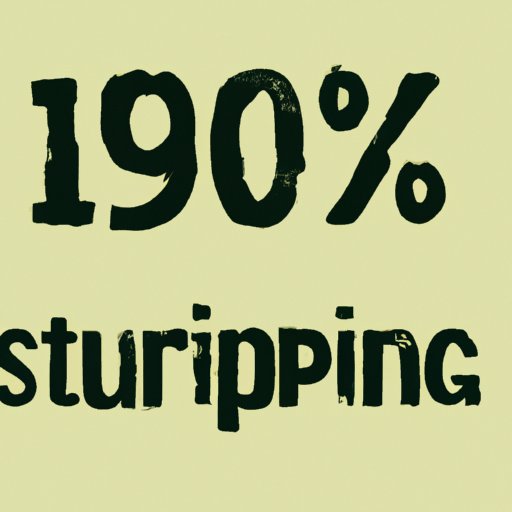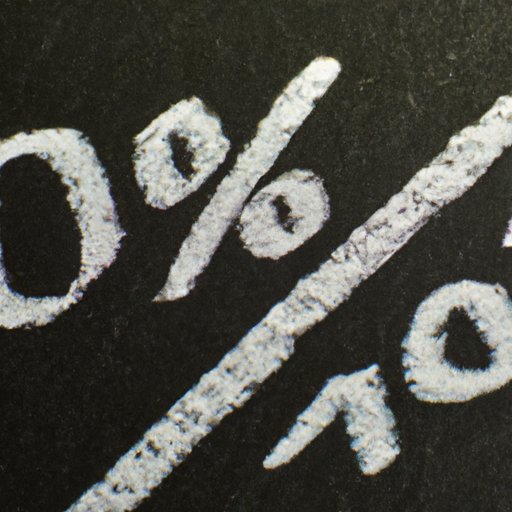Introduction
Percentages are used in virtually every aspect of life, from shopping to cooking to financial planning. It is crucial to understand how to find percentages accurately and efficiently to make informed decisions. In this article, we’ll explore quick tips, step-by-step guides, advanced techniques, and shortcuts to help you master percentage calculations.
Quick Tips: How to Find Percentage of Anything in Seconds!
Calculating percentages can be simple and quick. One way is to use proportions, which means converting percentages into fractions or decimals. For example, 50% can be converted to 0.50 or 1/2. From there, you can multiply the fraction or decimal by the total to find the percentage. Another method is to use mental math, such as rounding to the nearest tenth or doubling and halving numbers. These quick tips are useful for simple calculations, such as calculating a tip or a sale discount.
Breaking Down the Math: An Easy Step-by-Step Guide to Finding Percentages
For more complex calculations, it is helpful to understand the basic formula for finding percentages, which is:
Percentage = (Part/Total) x 100
This formula is used to find the percentage of a part relative to the whole. Here’s how to use it:
- Identify the part and the total
- Divide the part by the total
- Multiply the result by 100 to get the percentage
For example, if you have a test with 30 questions and you got 24 correct, you can find your percentage score by dividing 24 by 30, which equals 0.8. Multiply 0.8 by 100 to get 80%, which is your score.
The Ultimate Guide to Finding Percentages: Everything You Need to Know
There are many types of percentages, such as discounts, markups, and taxes, which require different formulas or methods. For example, to find the sale price after a discount, you can simply subtract the discount percentage from 100%, multiply the remainder by the original price, and divide the result by 100%. To find the markup price, you can use the formula:
Markup price = Cost x (1 + Markup percentage/100)
To effectively use percentages in real-world scenarios, it’s important to understand how they are used in different fields, such as business, science, and education. Additionally, using percentages effectively can help with budgeting, investing, and negotiating better deals.

Stop Guessing and Start Calculating: How to Accurately Find Percentages
Common mistakes when calculating percentages include forgetting to convert fractions or decimals to percentages, using the wrong formula or calculation, and rounding incorrectly. To avoid making these mistakes, it’s helpful to double-check your work, use the correct formulas, and pay attention to the details. For example, when converting decimals to percentages, move the decimal point two places to the right and add the percent symbol.
Mastering Percentages: A Comprehensive Tutorial for Every Situation
Advanced techniques for finding percentages include solving proportions, using algebraic equations, and applying trigonometry. These techniques are useful for solving complex problems, such as calculating compound interest or determining probabilities. Practice exercises can help build skills and confidence in using these techniques.
Crunching the Numbers: How to Calculate Percentages Like a Pro
Tools such as calculators and spreadsheets can make percentage calculations easier and faster. Additionally, mastering mental math can help speed up calculations and increase accuracy. To improve mental math skills, try practicing rounding, estimating, and using shortcuts like doubling or halving numbers. Using these tools and techniques can help you become a pro at percentage calculations.
Simple Methods for Finding Percentages Without Breaking a Sweat
If you need to estimate percentages quickly, you can use rounding or benchmarking. Rounding involves rounding the numbers to the nearest whole number or rounding up or down to a percentage that is easy to work with, such as 10%. Benchmarking involves using benchmarks, such as 25%, 50%, or 75%, to estimate percentages. These methods are useful for making quick decisions or for situations where accuracy is not critical.
Conclusion
Calculating percentages is an essential skill for making informed decisions in various situations. Whether you use quick tips, step-by-step guides, advanced techniques, or shortcuts, it’s important to choose the method that works best for you. Remember to double-check your work, use the correct formulas, and pay attention to the details.
